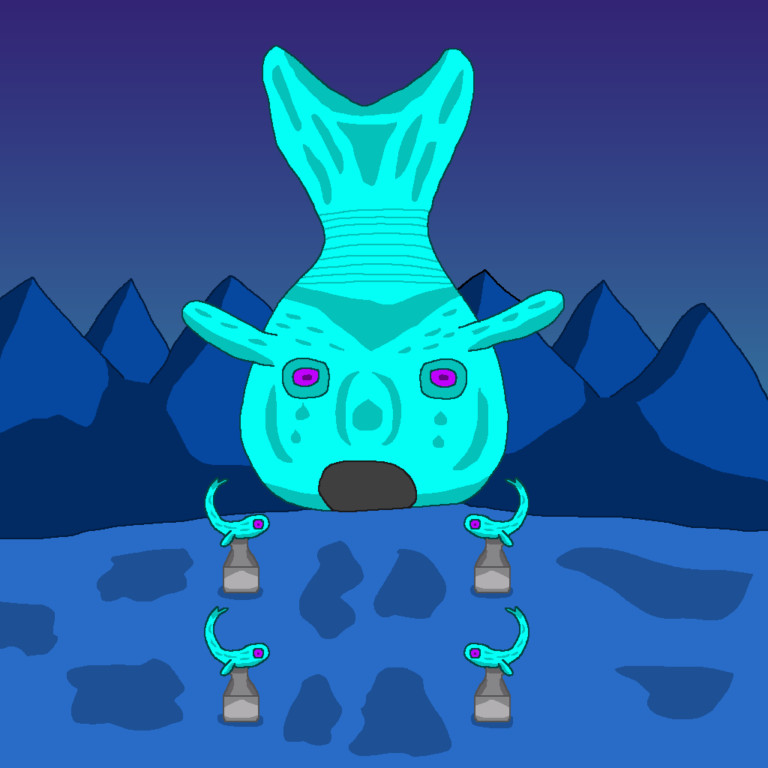Join US
Do you want to build the fantasy world you’ve always dreamed of?
Subscribe to receive notifications when a new post is out and for our monthly newsletter!
You can always unsubscribe anytime.


Many dungeons in fantasy revolve around the elements. Each element comes with its set of colors and styles like green for forest, red for fire, and so on. This helps each one stand out and gives them something no other has. Nowhere is this more evident than the water dungeon, which is usually blue.
The water dungeon is generally considered the toughest for stories that prominently feature dungeons. This is because the hero has to manipulate the water level, either for a whole floor or part of it, which makes navigating cumbersome. It’s easy to get lost — looking at you, Water Temple from Ocarina of Time! It also requires a fair more amount of backtracking, which many people dislike.
The frustrations people feel when journeying through the water dungeon makes them not see the amazing design and architecture that goes into it. They don’t get to see the beauty or appreciate the cool features that come with it which is hard to replicate with any other element.
If you could describe the ambience of the typical water dungeon in one word, deceptive would be an appropriate word to use. While you’d barely break a sweat exploring it, the reflections of the water bouncing off the walls makes you forget you’re in a very dangerous place where you can easily drown. This illusion is one of this elemental dungeon’s main strengths.
As if adventuring through an expansive place where mastery of the water is key to reaching the boss isn’t enough, you have to contend with monsters. Not just any monsters but those who can swim or live underwater. These creatures make fighting under the surface more difficult than up above.
This is the third in a series examining dungeons. If you’re interested in the first two, here they are:
Diving into The Mystical World of the Forest Dungeon
A Peek into the Fire Dungeon’s Searing World
We have even more articles, all of which can be found on our blog page!
The first thing to know about water dungeons is that they’re found either underwater or in a place full of water like a lake or the sea. The underwater entrance can be literally on the lake- or sea-bed or on the side of a wall. Islands right smack-dab in the middle of the lake are a popular choice to put a water dungeon.
Why does its location matter? Because it determines what kind of design you can develop to make an amazing dungeon. There’s two major styles to use for this element and each one is different from the other.
The first one is the shape of a fish. Since fish is associated with water, this style is meant to honor a specific type. It could be a patron deity or a fish that’s important to the locals. It’s a way to show how much it’s revered. This style tends to be found either underwater or in a prominent location like a waterfall.
Upon seeing the fish-shaped building for the first time, you immediately know it’s a water dungeon. This eliminates the guesswork as to what kind it is. On the other hand, knowing that you’re about to enter it means you know you’ll have to manipulate the water somehow in order to successfully complete it.
The second major style is a holy site, similar to that of its fire counterpart. It’s a place where a select few worship the water deity and only those who have access can enter. You can find such places above the water though some floors can go underwater. It’s typically a large structure of some sort.
While you can see a fish design here, more likely it’ll be a different kind more in line in what it represents. It can take the appearance of a religious building like a church or cathedral or one you create yourself. If you’re making one in this vein, take this opportunity to come up with an unique design that looks great and matches the area it’s in.
Even though a water dungeon may not be popular, its ambience still matters a great deal. After all, you want people to feel what the dungeon is communicating to them. Always keep that in the back of your mind when deciding on the ambience.
Water can be deceptive in nature. While it only reflects what you see, how you perceive what you see is equally important, if not more. This is because water in fantasy is meant to be pure and the viewer sees what he truly believes in his heart in his reflection.
This deception is illusionary. It’s meant to deter you from being aware that you’re in a perilous place where you’re at the mercy of water. You’re led to believe that as long as you remain above water, you’re safe when nothing could be further from the truth.
Both the two major design styles use the illusionary nature of water to achieve the same results though the paths they take to get there differ. The diverging paths make for dynamic, interesting appearances. This is done by manipulating the water, which is required to successfully complete the dungeon, to open new routes that lead to new areas previously unaccessible.
For a dungeon styled like a fish, you get a sense of reverence. You see it all around, from the intricate tile patterns depicting the fish to the little statues scattered throughout the dungeon. It’s as if you’re in a place paying tribute to a fish that’s held in high honor by the locals.
For a water dungeon that masquerades as a holy site, you get the same feeling as that of its fire brethren: you feel the holiness seeping through the walls. Little adornments depicting the deity stand on tables or hang on the walls. There’s even an altar to worship said deity.

The water dungeon has a wider array of enemies compared to the others. Being a mixture of land and water, monsters of both kinds appear in many of its rooms. Each one brings its own set of challenges when battling them.
It can’t be a water dungeon if there’s no fish or aquatic enemies. Sure you can go with the classics like the piranha, octopus, jellyfish, shark, and so on. But you know what would be better? Creating your own unique fish species!
Another group of aquatic monsters have shells. This includes lobsters, clams, oysters, etcetera. Their shells are impervious to damage, meaning you’ll have to wait until they show their soft flesh in order to have a chance to defeat them.
For the landlubbers, you can’t go wrong with crabs or arachnids. Bats are another great choice since they’re so versatile you can put them anywhere. Really any monsters that dwell in close proximity to the water will suffice.
A bonus category is the group of enemies that float just underneath the surface but can attack you on land. Fish shooting jets of water that damage you or those that leap out of the water are great examples. This makes for interesting combat as you’re forced to employ different tactics to defeat them.
What do you see for the boss of a water dungeon? Firstly, it’s a larger version of a monster fought throughout the dungeon, usually aquatic, that serves as its final challenge. Secondly, it’s an one-of-a-kind creature where you have to come up with a wholly new strategy to vanquish it. No matter which one you go with, design a fantastic boss with an equally great battle that your audience will remember!
There’s nothing like diving underwater in a water dungeon. You get to explore it in a whole new dimension which forces you to alter your strategy in how you approach things. This is one reason why water dungeons are considered tougher than most others.
In order to knock it out of the park, go with a stellar design. You can go one of two ways. Paying tribute to a fish or another underwater creature or having it be a holy site to honor a deity. Either one works and before long, you’ll have created a beautiful design that showcases what the inside is all about!
Next comes the ambience. The illusionary nature of water gives you a golden opportunity to design a way to manipulate it as well as being a showpiece of the dungeon. You want your audience to feel like they’re in a special place but they shouldn’t ignore the dangers that come with it.
Don’t forget to populate a water dungeon with enemies. They make it feel like a real place. Additionally, they pose a challenge to you since you may not be able to use what you normally use to slay monsters. You may have no choice but to come up with new ways to take them down.
Featuring a water dungeon in a story where dungeons are a major setting is an absolute must! For starters, they’re a step up in difficulty which forces the hero to step up his game. In other words, it makes him stronger and more ready to face off against the villain.
There’s no reason not to have a water dungeon in your story! Just maybe, you can come up with one that leaves your audience wanting more!
Let me know what you think in the comments below. (Note: this is an account-exclusive feature).
If you don’t have one, you can register here. It only takes a few moments of your time!
Liked this article and want to subscribe? All you have to do is fill out the form below and that’s it!
Thanks for reading this and until the next time,
Sunfire
Subscribing means you receive:
You can always unsubscribe anytime.
Do you want to build the fantasy world you’ve always dreamed of?
Subscribe to receive notifications when a new post is out and for our monthly newsletter!
You can always unsubscribe anytime.